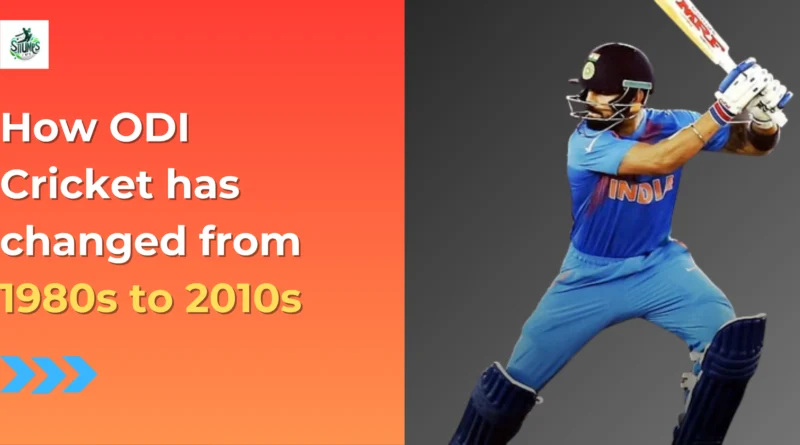ODI Cricket: The Revolutionary Shift from the 1980s to the 2010s
The evolution of One Day International (ODI) cricket from the 1980s to the 2010s marks a significant transformation in how the sport is played and perceived. This period witnessed a revolution in cricketing strategies, playing styles, and fan engagement, transforming ODI cricket from a tactical contest into a high-octane spectacle.
The 1980s: Laying the Foundation for ODI Cricket
The 1980s were a defining era for ODI cricket, establishing the foundation for the format’s future. During this decade, the sport was characterized by a conservative approach, with teams focusing on steady run accumulation and strategic wicket preservation. The limited-overs format, still relatively new, was defined by careful batting and disciplined bowling.
Key Players of the 1980s
1. Viv Richards (West Indies):
– ODI Career: 1975-1991
– Matches: 187
– Runs: 6,721
– Batting Average: 47.00
– Strike Rate: 90.20
Viv Richards was a trailblazer in ODI cricket, known for his aggressive batting style. He set new benchmarks for how limited-overs cricket could be played, making him one of the most iconic figures of the 1980s.
2. Kapil Dev (India):
– ODI Career: 1978-1994
– Matches: 225
– Runs: 3,783
– Wickets: 253
– Strike Rate: 95.07
Kapil Dev, with his exceptional all-round abilities, was pivotal in India’s ODI cricket success. His aggressive batting, particularly in the 1983 World Cup, and his reliable pace bowling made him a key figure in shaping the ODI format during the 1980s.
3. Ian Botham (England):
– ODI Career: 1976-1992
– Matches: 116
– Runs: 2,113
– Wickets: 145
– Strike Rate: 79.10
Ian Botham was a dominant force in ODI cricket during the 1980s, known for his fearless approach with both bat and ball. His ability to change the course of a match made him one of the most impactful players of his time.
The 2010s: The Era of Aggression and Innovation
The 2010s brought a radical shift in ODI cricket, with the format becoming more dynamic, aggressive, and influenced by technology. This era saw the emergence of power-hitting, innovative shot-making, and the use of data analytics to refine strategies. The game evolved into a faster, more entertaining spectacle, appealing to a global audience.
Key Players of the 2010s:
1. Virat Kohli (India):
– ODI Career: 2008-Present
– Matches: 295
– Runs: 13,906
– Batting Average: 58.18
– Strike Rate: 93.54
Virat Kohli is often regarded as the finest ODI batsman of the 2010s. His consistency, especially in chasing targets, and ability to adapt to different match situations have made him a modern-day cricket icon.
2. AB de Villiers (South Africa):
– ODI Career: 2005-2018
– Matches: 228
– Runs: 9,577
– Batting Average: 53.50
– Strike Rate: 101.09
AB de Villiers revolutionized ODI cricket with his innovative and unorthodox batting. His ability to score around the wicket made him one of the most dangerous and entertaining players in the 2010s.
3. Mitchell Starc (Australia):
– ODI Career: 2010-Present
– Matches: 121
– Wickets: 236
– Bowling Average: 22.97
– Economy Rate: 5.21
Mitchell Starc became a key figure in ODI cricket with his blistering pace and ability to deliver in crunch situations. His skill in the death overs, particularly his Yorkers, was a vital asset for Australia throughout the 2010s.
Statistical Comparison: 1980s vs. 2010s
– Average Team Score:
– 1980s: 197 runs
– 2010s: 227 runs
– Average Batting Strike Rate:
– 1980s: 73 runs per 100 balls
– 2010s: 87 runs per 100 balls
– Number of 300+ Scores:
– 1980s: 12
– 2010s: 378
– Number of Centuries:
– 1980s: 134
– 2010s: 747
Conclusion:
The evolution of ODI cricket from the 1980s to the 2010s illustrates the sport’s remarkable ability to adapt and innovate. While the 1980s established the foundation of ODI cricket with strategic, methodical play, the 2010s brought a wave of aggression and entertainment, making the format more appealing to a global audience. Players like Viv Richards, Kapil Dev, and Ian Botham set the stage in the 1980s, while stars like Virat Kohli, AB de Villiers, and Mitchell Starc took the game to new heights in the 2010s. This transformation underscores the dynamic nature of ODI cricket, ensuring its continued popularity and relevance in the cricketing world.
